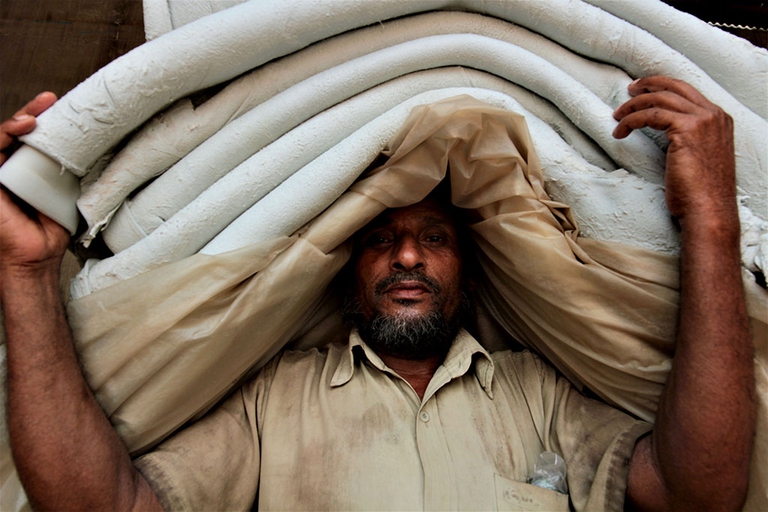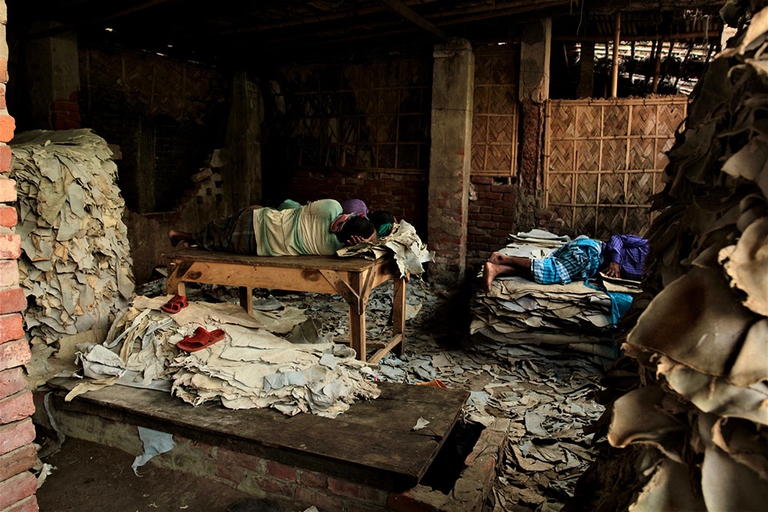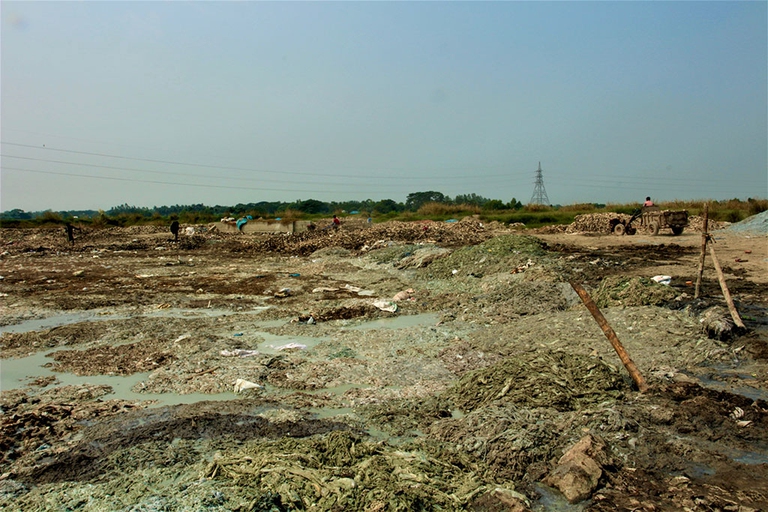
Sharon Lavigne, one of the six winners of the 2021 Goldman Environmental Prize, is fighting to protect her community from plastics corporations.
A journey to discover leather tanneries in Dhaka, the capital of Bangladesh, among terrible working conditions, pollution and laws left unenforced.
When in April 2017, under international pressure the Bangladeshi government forced over 150 tanneries to move from Hazaribagh, a neighbourhood in the old part of the capital Dhaka, to a new area outside the city, in the Savar district, many were convinced that things were going to change. But regardless of all the premises and promises, Bangladeshi tanneries – which make leather for the production of shoes, belts, wallets and bags sold all over the world, including by large brands – continue dumping toxic substances in the Dhaleshwari River. In addition, the exploitation of underage workers persists and the workforce remains underpaid, operating in terrible safety conditions and suffering serious health consequences.
Read more: Bangladesh, in the Kutupalong refugee camp among Rohingya women and their stories of abuse
You could say that the only things that have changed are the location, the name – Savar Leather Industrial Park – and the river that is being polluted. A water course embedded in the region’s intricate fluvial network and directly connected to the Buriganga River, which flows through Dhaka and used to be contaminated by 22,000 cubic litres of toxic waste every day.
In the small Hazaribagh area there used to be almost 200 tanneries that produced 95 per cent of Bangladesh’s leather output. This occurred in the absence of a waste disposal plant where solid and liquid toxic refuse from the tanning process could be safely disposed of. Waste was poured directly into the river from which over 180,000 people get their drinking water, now permanently polluted. In 2013 the district was classified as the fifth most polluted place in the world by researchers from the International Green Cross and Blacksmith Institute.
The approximately 15,000 people who worked there and those who lived in the surrounding area were continuously exposed to chemical substances in an unhealthy and extremely dangerous environment. Bangladeshi authorities were indifferent to their plight, a fact denounced multiple times by environmental and human rights organisations such as Human Rights Watch. The first plans for relocation were made in 2003 but kept being postponed until 2017, when Dhaka’s council set up the “green” Savar Tannery Park in Hemayatpur.
Upon arrival, after a two-and-a-half-hour bus journey from the capital, it’s immediately clear that the industrial area is rather isolated and incomplete. Basic infrastructure such as roads, drainage canals and fire safety systems is severely lacking, and the buildings that house the tanneries are nothing more than concrete high-rises whose upper floors haven’t even been completed. Little carts roll down the dusty streets laden with blue-tinted pelts, ridden by bearded men wearing only trousers or shorts and flip-flops. These workers, covered in sweat, seek some respite from the sun and sweltering heat by wearing a topi, a traditional hat used in Bangladesh.
The hot air is made almost unbreathable by a strong, pungent smell. A mix of putrefaction and chemical substances that becomes stronger and stronger the closer you get to one of the buildings. Inside the Siful Islam tannery it’s as hot as hell and there’s very little light. In a labyrinth made of bags full of chemicals and stacks of pelts ready for tanning, young boys cut and prepare the hides. Not far from here there are several large tanks topped by enormous wooden barrels. The stench is really hard to stomach and the vapours makes your eyes burn. Groups of workers without any protective equipment handle the pelts, dipping them in the vats before putting them through the machinery.
Sumon, 38, moved here from Hazaribagh: “The situation in the factory is a slight improvement, but we still have a lot of health problems and work as if we were in a jungle. There are no lodgings, it’s hard to buy food and if you suffer an injury there are no hospitals or healthcare facilities nearby. At least in Hazaribagh, in one way or another, we had access to these things”.
Bangladeshi tanners work an average of ten hours a day in these conditions and their salary roughly equates to 157 dollars a month. Direct contact with chemical agents happens in all phases of the tanning process and causes short as well as long-term health problems. Workers say they often suffer from skin and respiratory ailments, as well as terrible headaches in addition to frequent bouts of diarrhoea, and sometimes lose consciousness. The substances which they’re most frequently in contact with are sulfuric acid, lead and chrome. Dangerously high quantities of these are also found in the Buriganga River.
To complete the picture, it must be added that work-related accidents are extremely frequent, often leading to the amputation of limbs. Abul Kalam Azad, president of the Tannery Workers Union, has strong and legitimate grievances: “We’re very frustrated by the situation. The government made promises, it said there were going to be hospitals, accommodation for workers and even improved salaries. But the promises weren’t maintained”.
Opposite a large side door in the tannery other workers are emptying solid waste from a tank using shovels. The gelatinous substance, whose colour ranges from white to light blue, is made of animal fat, hairs and chemical refuse from the tanning process: it’s nicknamed “wet blue”. Vats full of it are taken outside to a wide open space where they get dumped. This “landfill” is a few metres away from the river and there are no measures in place to prevent spillage.
“There’s a lot of pollution here”. Young Abdul Goni smiles and walks towards us, covered in sweat. “I’m from this area and found work here when the tanneries moved. I’ve noticed that the river has been changing for about a year, mainly its colour. This happens because waste is discharged here”. Abdul walks over to the bank of the river and shows us two large cement pipes from which a black liquid is draining into the mud, which has turned grey. On contact with the mud, the liquid makes a white-yellowish foam which slowly spreads out among the reeds and floating plants, into the river.
“The new industrial area should make use of the Common Effluent Treatment Plant (CETP), which, however, doesn’t function correctly. At the moment, a water source for thousands, possibly even millions of people is being contaminated”. These are the words of Abu Naser Khan, president of the Save the Environment Movement (POBA). The NGO leader adds: “Even if the plant were functional, it wouldn’t be able to process the waste from all of the tanneries, especially during the Id Al-Adha sacrificial festival, when the annual peak in production occurs”.
The lack of concern for workers’ rights and environmental problems, as well as the laxity in the Bangladeshi government’s enforcement of existing laws are the main causes behind such issues. However, responsibility doesn’t just lie with the authorities and tanneries’ owners: it also stems indirectly from demand for leather products in North America, China and Europe. Therefore, to a certain extent, responsibility also lies with us. Major brands source materials from producers affiliated with these tanneries. “They should be more careful and exercise pressure to help bring about positive change, as should consumers,” Naser Khan states.
It must be said that moving the tanneries seems to have had a negative effect on the sector as a whole, as numerous tannery closures and recent economic data showing plummeting exports demonstrate. The latest report published by the Export Promotion Bureau (EPB) shows that these fell 17.5 per cent in 2018 compared to the same period the previous year, with a revenue of 268 million dollars representing a major loss against 325 million in 2017. The crisis is mainly due to a fall in production. Of the 155 tanneries that moved to Savar, 125 are in operation and of these only 25 are working to their full potential. The move sent many owners into severe debt and things have been slow to get back into gear. The government is worried about the hardship faced by one of its most important sectors, which contributes almost 4 per cent of the country’s GDP.
Many have speculated that the move to Savar was pushed for by Bangladeshi leather lobbies, which have strong institutional ties and tried to bring about the failure of smaller tanneries, too weak and debt-ridden to be successful in the transition, thus creating an oligopoly through which they can better control the sector. “This is a great threat to workers and the environment – union representative Kalam Azad says, expressing his worries –, if the situation doesn’t change, everything will be in the hands of a small group of powerful individuals who will set rules without having to worry about unions, whose bargaining position will be greatly diminished”. Even the Dhaka government could lose its hold on an important sector taken over by an overly-powerful lobby, as has happened countless times all over the world.
In any case there are certain instruments that could be used to prevent all of this from happening and, leaving aside likely lobby involvement, Naser Khan concludes that “what is lacking in Bangladesh is the political will to seriously apply the law and respect the population and our ecosystem”. The consequences of the trade war between Beijing and Washington are leaving the executive in Dhaka in the difficult situation of having to mediate between the sales needs of a sector hit hard by the decrease in Chinese demand, and external pressure over environmental and human rights issues. But it seems clear that those paying the price are workers and farmers. That is, the poorest people in the country.
Siamo anche su WhatsApp. Segui il canale ufficiale LifeGate per restare aggiornata, aggiornato sulle ultime notizie e sulle nostre attività.
![]()
Quest'opera è distribuita con Licenza Creative Commons Attribuzione - Non commerciale - Non opere derivate 4.0 Internazionale.
Sharon Lavigne, one of the six winners of the 2021 Goldman Environmental Prize, is fighting to protect her community from plastics corporations.
Plastic pollution is airborne too. Microplastics are being carried across continents by the wind, as a recent study reveals.
Levels of particulates in New Delhi in 2020 were once again far above safety thresholds, with extremely serious health consequences for its citizens.
A major oil spill in the Ecuadorian Amazon in April has left the Coca River polluted. The indigenous Kichwa are suing the companies whose pipelines broke.
Molecules that eat up plastic waste, including PET bottles, may soon become widely used as scientists leap ahead in developing new super enzymes.
In Italy’s Land of Fires between Naples and Caserta, activists like Carmen Medaglia are fighting to promote new ways of managing waste.
Toxic substances in Kamchatka’s waters have killed 95% of marine fauna and caused health problems for surfers. The causes, however, are still unknown.
A Magellanic penguin was found lifeless on a Brazilian beach: in its stomach, an N95 face mask. Researchers believe the animal died from ingesting it.
The drop in air pollution during worldwide lockdowns helped prevent thousands of premature deaths. But the situation is returning to pre-crisis levels.












